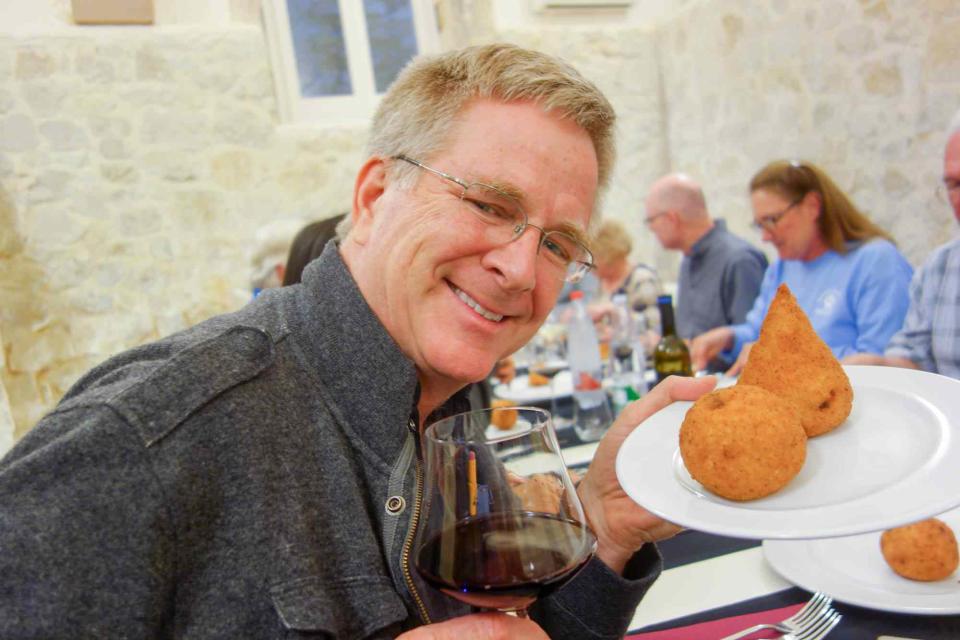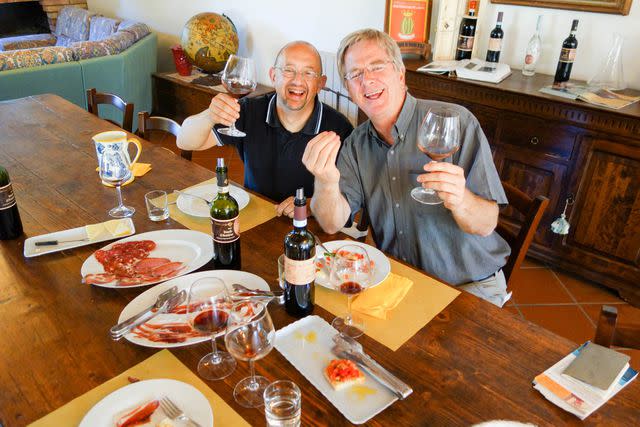Rick Steves Just Gave Us His Best Tips on How to Find a Great Restaurant on Vacation
- Oops!Something went wrong.Please try again later.
Here's how Rick Steves finds his favorite restaurants in Europe.

Courtesy of Rick Steves
Rick Steves is committed to eating like a local. He doesn't want "best of" and "top 10" lists, he wants to hear the local language as he digs into fresh food, rather than eating at restaurants that sacrifice quality to cater to tourists. Steves is the TV host, guidebook author, and founder at the helm of Rick Steves’ Europe, known for his travel philosophy of prioritizing local alternatives over expensive hotels and restaurants.
In a recent interview with Travel + Leisure, Steves shared some of his best tips for dining out in Europe, including how to be a more thoughtful consumer and avoid tourist traps. There are a few golden rules Steves follows when choosing restaurants in Europe that can help travelers eat more locally, seasonally, and culturally.
“It’s being part of the party, rather than just part of the economy,” Steves said.

Courtesy of Rick Steves
Step Away From the Sightseeing Streets
Sometimes seeking out only the very best restaurants can lead to a frustrating experience, Steves said, because if it’s the best, it’s famous — and that means locals and tourists are both vying for those reservations.
Instead, he said, be willing to try a restaurant that is perhaps lesser known, but no less good.
“Every night, I’m choosing a place to eat dinner, and I want to be free to go where the spirit takes me, where the mood is, where the serendipity is good,” Steves said.
(If you still want to make that one all-important reservation at a can't-miss spot, go ahead, just make sure to do it ahead of time.)
In choosing a restaurant, Steves said, examine the actual street where you are looking to dine. Is it the neighborhood's high-rent street, where owners are probably paying a lot of money to be on a busy, trendy road in the heart of a popular area?
As an alternative, he said, why not walk to a nearby street where the restaurant might be paying a little less in rent and the area isn’t swarmed by other tourists. A lot of the restaurants on the bigger, more popular streets are not locally owned, which doesn’t attract locals to eat there, Steves said.
“I will find a place on the low-rent street a few blocks away, thriving with happy, local customers,” he said. “If you find that place, and it feels good to you because it’s just packed with locals eating, that’s going to be a great dinner.”
Pick a Menu That Speaks to You — in the Local Language
Another telltale sign of a restaurant geared at tourists, Steves said, is a large sign out front that declares, “We speak English” or “No frozen food.” These spots tend to have a pre-printed menu, offered in multiple languages, that remains the same year-round.
“Everything’s wrong about this, and you’re going to be eating with other tourists,” Steves said.
Instead, he said, look for spots with a smaller menu, handwritten or printed with a date, which implies the chef is cooking based on what is fresh and in season. If it’s in the local language, even better, Steves said, because that means they are catering to locals, not tourists.
“A smart eater can go to a good restaurant, look at the menu, and know what month it is and where they are,” Steves said.
For instance, Steves said there are plenty of people who travel to Paris and insist on French onion soup, no matter the time of year. Onion soup is a French specialty in the winter, but plenty of restaurants will gladly take your money and serve cold-weather soup in the summer, rather than sourcing fresh ingredients.
Eating seasonally is a great way to explore and learn about the region’s culture, Steves said. When a restaurant cooks with the seasons and a zero-kilometer philosophy of serving local goods, “it’s a beautiful thing,” he said.
That’s part of why Steves wrote his newest book, “Italy for Food Lovers,” as a way to showcase food as an inroad for Americans into European — in this case, Italian — culture. The book is a practical guide for travelers who want to learn more about the history and culture of Italian cuisine — and learn some of Steves' favorite restaurants and tips for eating abroad.
The book, written with co-author Fred Plotkin, showcases food and wine specialities from the country’s 20 regions. There's also an Italian food glossary, details about Italy’s coffee and wine culture, how (and what) to order, and a deep dive into Italian eating and drinking traditions.
“We travel to celebrate a culture, to understand the people and the story of that nation,” Steves said. “If you know a little bit about what to order, and what their traditions are … it's a fun thing to be able to share with other travelers.”
Locals Matter More Than Locale
Finding a family-owned and -operated establishment, Steves said, is a rewarding way to indulge in a great meal while also supporting local businesses. He said the character and charm you find at these spots, where the parents or grandparents have passed down the business to their children, is hard to replicate and makes for a memorable travel experience.
“When you go to a small, family run place, run by people who have found their niche, they really enjoy it,” Steves said. “And you feel like they know their staff, they know their customers — it’s people to people.”
That’s why Rick Steves’ Europe tours and guidebooks focus on these types of restaurants. By learning about the local culture through food, travelers might also be inspired to slow down and take in more of the experience around them as they eat.
“I’m no gourmet critic of food, but I know a great memory when I see one,” Steves said.
Steves said rather than visiting a place that puts its money and energy into advertising and getting to the top of those "best of" lists, what he loves most about local restaurants is the atmosphere. He wants to find restaurants where the money goes back into the community and the energy thrives because of the people in the restaurant.
“What distinguishes a good trip is not, ‘How good was your gelato?’ but the people you were licking it with,” Steves said. “It’s those connections that carbonate the whole experience.”
For more Travel & Leisure news, make sure to sign up for our newsletter!
Read the original article on Travel & Leisure.

